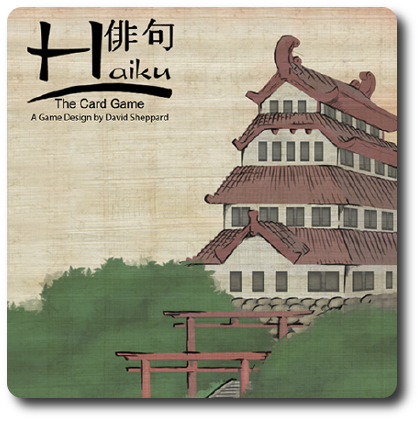
The Basics:
- For ages 8 and up
- Variable number of players (dependent on game variant)
- Variable game length (dependent on game variant)
Geek Skills:
- Active Listening & Communication
- Counting & Math
- Logical & Critical Decision Making
- Reading
- Semi-Cooperative Play
- Hand/Resource Management
- Imagination
- Auctioning, Bidding, & Trading
Learning Curve:
- Child – Easy
- Adult – Easy
Theme & Narrative:
- Using creativity and logical thinking, create haiku poems to entertain and impress!
Endorsements:
- Gamer Geek rejected!
- Parent Geek approved!
- Child Geek approved!
Overview
Zen for the table!
In the form of a card game,
Art and game play blend.
Haiku, an independent and self-published card game by David Sheppard, is comprised of 120 Syllable cards, 60 point tokens, 36 Season cards, 24 Calligraphy cards, 6 player screens, and 3 game variant summary cards. The point tokens are simple plastic discs and nothing to get excited about, but the art and illustration on the Syllable, Season, and Calligraphy cards will immediately bring a warm smile to any art enthusiast who enjoys the Zen paintings and calligraphy created in the 1600’s.
The Zen of Cards
The game comes with three different card types. Depending on which game variant is being played, 1 or more of the card types will be used. Each card type is unique in both its design and its look.
The Syllable cards, which are used in all the game variants, contain three important pieces of information. The first is a single word or a very short phrase. These words are used to create the haiku poems. The second is a number value. The number value is equal to the number of syllables the word or phrase on the card is comprised of. The third, which matches the card’s background illustration, is the name of one of four different seasons: Spring, Summer, Autumn, and Winter.
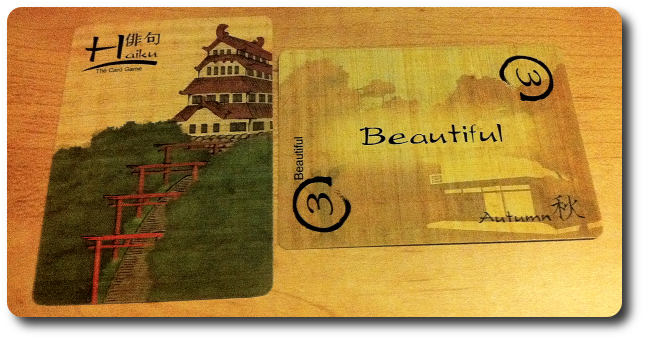
The Season cards, which are used in one of the game variants, contains 6 cards of each season, 6 cards that represent a Festival, and 6 cards that represent a wealthy patron of the arts. Like the Syllable cards, the illustrations are very Zen.
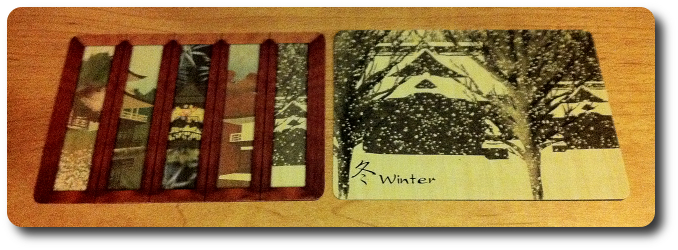
The Calligraphy cards, which are used in 2 game variants, contain number values 1 through 3. The number presentation is illustrated to look like it is on the working table top of a calligraphy student, complete with suzuri (inkstone) and bamboo brush.
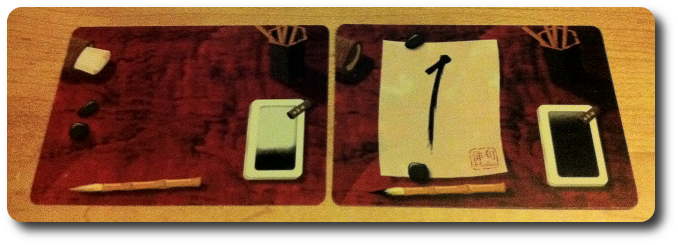
A Game of Many Games
Haiku is not a single game. Rather, it is a box of cards and other components that are used in a total of 6 different game variants. Each game variant is summarized here.
Haiku Helpers
In this game variant, the players take and shuffle the Syllable cards and deal out 3 cards to each player, placing the remaining deck in the middle of the playing area. On a player’s turn, they will either draw a card from the deck, play a card to their haiku, or play a card to an opponent’s haiku. The haiku poem that is created must use the traditional seventeen syllables in three lines. Five syllables in the first, seven in the second, and five in the last line. Additionally, only one line at a time can be created in a poem and must go in sequential order starting at the top and working down. A fan of traditional Japanese haiku poetry will instantly recognize this visual form of three lines as the “English” version of haiku. As such, there is technically a correct way to structure them. Either the first or the last line being a fragment and grammatically independent of the other two lines that are grammatically dependent to become a single phrase. This article does a great job of explaining how a haiku poem is created.
Whenever a player completes a line in a poem, regardless if it is theirs or their opponent’s, they are awarded a point token. Game play continues until all poems have been completed. Once completed, all the players take turns reading their poems out loud.
The player with the most point tokens at the end of the game wins.
Haiku Hustle
In this game variant, the players take and shuffle the Syllable cards and each player draws 7 cards each. On their turn, if the player can complete a haiku using the cards in their hand, they lay them down on the table in front of them. These cards are then set aside and the player receives one point token. If they cannot complete a haiku, the player discards 3 cards and will draw up to 7 on their next turn.
If the player already has a haiku created on their turn, and they have the right cards to create a new haiku poem, the previously played cards are discarded and replaced with the new cards from the new haiku. The cards from the old haiku and the cards from the new haiku can never bet mixed or grouped.
Once a player completes 5 haiku poems, having earned 5 point tokens, the game immediately stops. The player with the 5 point tokens is now considered a “Master” poet and must search for an “Apprentice”. All the other players now use the cards in their previously played haiku and any cards in their hand to create a new haiku poem. The “Master” selects the player to who creates what they consider to be the best haiku and takes them on as their “Apprentice”.
The winners of the game are the “Master” and the “Apprentice”.
Haiku Rummy
In this game variant, the players take and shuffle the Syllable cards and each player is dealt 3 cards, face-down. Then the top 5 cards are discarded to create the discard pile. The remaining cards are left in the draw deck and placed face-down in the middle of the playing area. On the player’s turn, they draw “inspiration” from one source by either taking the top 3 cards from the discard pile, taking the top 3 cards from the draw deck, or take 2 cards of their choice from the top 10 cards in the discard pile (only available if there are 10 cards in the discard pile). These card are placed in the player’s hand.
The player now creates a haiku poem from the cards in their hand if they can. If they cannot, they take the top card from the deck or the discard pile. If they do create a poem, the cards are placed in front of them and they collect 1 points token and the top 2 cards from the draw deck. If a poem was created previously, they can replace it with a new poem. The replaced cards are sent to the discard pile.
Once a player has completed their fifth haiku, having earned 5 point tokens, all the other players have one last turn to attempt to create a haiku poem taking their turn as normal. Then starting with the player who triggered the endgame, all the players read their haiku poem out loud. Each player must take one of their point tokens and give it to the player they think created the best poem. The player with the most point tokens wins the game.
Haiku Auctions
In this game variant, the players take and shuffle the Syllable cards and each player is dealt 4 cards, face-down. The remaining Syllable cards are placed face-down to become the draw deck and the top 3 cards are drawn and revealed, placed in a row. The Calligraphy cards are now shuffled and placed face-down to become their own draw deck, with the top Calligraphy card drawn, revealed, and placed next to the deck. Each player also receives a player screen and 8 point tokens. The point tokens should remain behind the player screen at all times until used.
This is an auctioning game and the players will be bidding on the revealed Syllable cards. This is done with one player starting the bid with a minimum of 1 point token. The players then go in turn order either increasing the bid or passing. If bidding, the new bid value must always be more than the previous bid and used point tokens are placed in front of the player’s screen to show how much is being wagered. If the player passes, they can either take 2 point tokens and draw 1 Syllable card or take 1 point token and 2 Syllable cards. The cards are placed face-down in front of the player’s screen with the token or tokens to show they have passed. Bidding continues until all but one player passes.
The winner of the auction places their point tokens in the central pile and takes the 3 face-up Syllable cards. All the other players take their tokens and cards back, placing them behind their player screen. The winner of the auction, and only the winner, is now given an audience with the Emperor. If they can create a haiku using the cards in their hand (including the ones they just won), they do so and then recite it out loud. All the cards used in the poem are then ceremoniously placed in the discard pile. If the player used all 3 of the cards they just won in the auction, they are awarded a single point token. Then the player takes the revealed Calligraphy card and places it in front of them, keeping it visible to all the players. A new Calligraphy card is then drawn and revealed as are three new Syllable cards.
The game continues until all the Calligraphy cards have been claimed. Players add the number values on their Calligraphy cards to find their total score. The player with the highest score wins. The tokens are counted and used, but only to break ties.
Haiku Seasons
In this game variant, the players each receive 6 Season cards (Spring, Summer, Autumn, Winter, Festival, and Patron), dealt 5 Syllable cards, and a player screen. The draw deck for the Syllable cards remains in the center of the table, face-down, and within easy reach of all the players. Cards are then drawn from this deck until there is one Syllable card per season, with any extra cards discarded. The point tokens are placed in a pile to one side.
The game is played out in three phases. The first phase is referred to as the “Declaration phase” where all the players are dealt 3 Syllable cards and must decide if they can create a haiku using the cards in their hand to become a Poet, or cannot and become a Patron. This is decided in secret, so the players do not know how many of their opponents will be working for points and how many will be giving them. If the player wants to be a Poet, they place either their Spring, Summer, Autumn, Winter, or Festival Season card face-down in front of them. If the player wants to be a Patron, they place their Patron Season card face-down. All the cards are then revealed. For those players who are not Patrons, they move on to the next phase.
The second phase is referred to as the “Preparation phase” where all the players who are Poets must create a haiku poem and recite it to the table in hopes of winning the Patrons’ favor. The players who are Patrons grab 1 point token each and place them on their Patron card. Until all the Poets have finished creating their poems, the Patrons may trade their Syllable cards freely with the revealed cards in the center of the table. If a Patron takes a card, they must leave a card face-up with a Syllable value that is equal to the one they just took. A Poet will place their Syllable cards in the order they will be read for the haiku poem, placing their selected Season card next to it. When they are done, they should inform the table.
The third phase is referred to as the “Recital phase” and the players who are Poets now recite their haiku poems to the Patrons in turn order. Once all the poems are read, the Patrons award their point tokens to the player who they believe created the best haiku. Point tokens are placed behind player screens. The Poets keep the Syllable cards that match the Season card they used, making them into a stack, with the other Syllable cards being placed in the discard pile. Once completed, the next round continues with the first phase.
The game ends when a Poet reveals that they are using their last Season card, leaving them with nothing but the Patron card at the end of the Declaration phase. Patrons now take 2 point tokens each, and the Recital phase is carried out. When scoring points, players add up the syllable number value on their Syllable cards and any point tokens they have collected. The player with the most points wins.
Haiku Stackers
In this game variant, the players each receive 5 Syllable cards, 5 point tokens, and a player screen. A pen or pencil with some paper will also be necessary to keep track of points. With the remaining Syllable cards, a random haiku poem is build, line-by-line. Once the poem is created, 15 random Syllable cards per player are set aside to create the Syllable draw deck with any remaining cards being discarded for the duration of the game. Then the Calligraphy deck is shuffled and one Calligraphy card is placed, face-up, next to each of the poem’s lines. These are “line multipliers”. Once the line modifiers are placed, 5 random Calligraphy cards per player are set aside to create the Calligraphy draw deck with any remaining cards being discarded for the duration of the game.
On a player’s turn, they must complete a specific sequence of actions. The player’s first action has two options. The first allows them to draw either a Syllable card from the draw deck, and the second allows them to take 2 point tokens. The player’s second action also has two options. Th first option allows them to modify the haiku poem by putting one card of the same syllable value on top of another, combine multiple cards in a haiku into one stack, remove a stack of cards, or pay a point token and remove the entire line which then forces them to make a new line. The second option allows them to pay 1 point token to draw 2 Syllable cards, with each additional point token spent allowing the player to draw 1 additional Syllable card. For example, spending 4 point tokens would allow the player to draw 5 Syllable cards. The player’s third and final action is optional and can be skipped. The player can either sell a single Syllable card for a point token or trade 3 Syllable cards of the same season to draw 2 random Syllable cards.
Points are scored when a player modifies the poem. Card stacking scores the number of syllables on the card times the line multiplier, combining cards scores the number of syllables in the line times the line multiplier, scoring a number of cards they played to the new line plus any syllables in a line times the line modifier, or scoring a number of cards used times the total line multiplier for new lines they created. These points are written down on a piece of paper along with the player’s name.
The game ends immediately when either no more Calligraphy cards remain or the last Syllable card is drawn. The player’s final scores are now stated and the player with the most points wins the game.
Further Expansion and Personalization
The game already comes with 120 Syllable cards that can make hundreds of haiku poems. If even more cards are wanted, there are currently two expansion decks that contain 52 new Syllable cards that can be used with the existing Syllable cards or replace 52 of the original Syllable cards. While there are only two available at the time of this review (a reported third focusing on Shakespearean wordage is in the works), there is more than enough additional cards to keep a poet happy for countless hours.
The first expansion contains nothing and everything at the same time. How very Zen. They are blank cards that only contain a syllable number value and a season. It is up to the player to add a word or a phrase that matches the syllable count. In this way, a game enthusiast can add personal names, places, and things.
The second expansion is decidedly darker and is focused on Gothic imagery. Cold, dark loneliness, loss of joy, and everything else that makes the Gothic world so wonderfully uplifting. Using these cards, a game enthusiast can create a Gothic haiku poem to make even the most goth of Goths raise an eyebrow in a pretentious attempt of showing appreciation.
To learn more about Haiku and read the full rules, visit the game’s web page on the Game Crafter.
To learn more about the Haiku Blank expansion, visit the expansion’s web page on the Game Crafter.
To learn more about the Haiku Goth expansion, visit the expansion’s web page on the Game Crafter.
Prediction
This should be very interesting but also well received. Most of the games I put in front of my gaming groups are highly dependent on critical and logical thinking, with a good grasp of the benefits of strategy and tactics. Seldom do we put a game in front of them that is focused more on creativity. Games like this tend to be a breath of fresh air and are often well received by the Parent and Child Geeks. Not the case with the Gamer Geeks, however, who tend to scowl at any “game” that they don’t think is really a “game”. Therefore, I predict solid and positive endorsements from the Child and Parent Geeks and nothing but sarcasm from the Gamer Geeks.
The rules to each of the different game variants are very straight forward to learn and to teach. The rule book does have some spelling errors, but these are not terrible, nor are they confusing For example, instead of the word “dealt”, the word is spelled “dealth”. Very small mistakes that will make the English Major cringe (which I am and I did), but for anyone else, they won’t find it to be an issue. My 8-year-old read the rules for Haiku Auctions and had no problem teaching me how to play that game variant, for example.
And so, after I gave my oldest little geek a short, but overly detailed lesson on what makes a haiku poem a haiku poem, we were ready to go. We would start with the Haiku Helper game variant as that would allow me to instruct when needed and play as an equal at the same time with the semi-cooperative play. After I answered all his questions and made him sit down for the 10 minute, from-the-hip lecture on why it was important to appreciate poetry, he was overly sick of me and just wanted to play the game. But before we started, I asked him his thoughts on the game so far.
“This game sounds easy. Look at me! I’m a poet and I didn’t even know it!” ~ Liam (age 8)
Cute. Let’s see if my son’s level of enthusiasm makes up for his overconfidence and weak rhyming skills.
Final Word
As predicted, the Child and the Parent Geeks both enjoyed the game a great deal. They thought the game did an excellent job of allowing the players to be creative and enjoy a casual game with a very light level of competitiveness. Their primary focus of praise was how easy if felt to create poems that were more times than not strangely profound. That might be the case for some, but there were also many that were total disasters. The Parent Geeks acknowledged this and the Child Geeks didn’t understand what all the fuss was about. Of the different game variants, the Child Geeks liked Haiku Helpers and Haiku Hustle the best. The Parent Geeks enjoyed Haiku Auction and Haiku Seasons the most. Neither group much liked Haiku Stackers. Regardless of which game variant they most appreciated, both the Child and the Parent Geeks were most pleased to endorse it. One Parent Geek suggested that this game could also be used as a creative exercise in writing classes and by teachers who were currently lecturing about haiku poetry. Anytime you can get a game into the classroom sounds like a great deal to me.
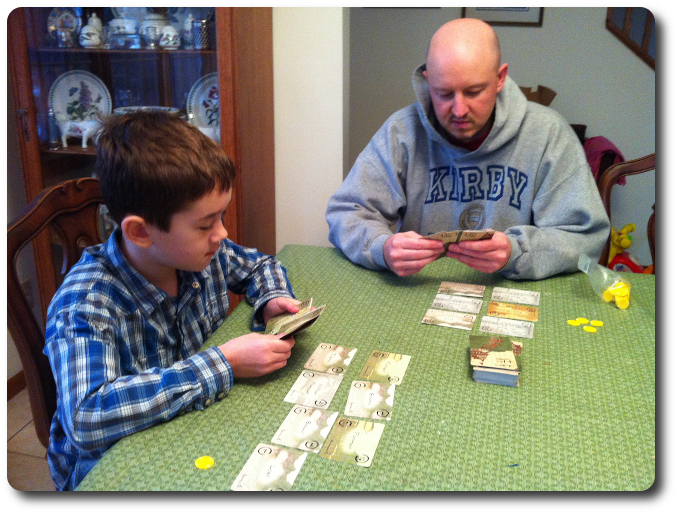
Teaching my little geek poet the finer points of a haiku poem
The Gamer Geeks were not at all impressed with this game, although they begrudgingly admitted they liked a few of the game mechanisms used. Regardless, they hated how entirely subjective all the game variants felt. There was no bar they could use to measure the value of one haiku poem to another, and more times than not, you could create a haiku poem that made no sense and it was perfectly legal in the game variant. This felt broken to the Gamer Geeks and made the entire game play experience worthless to them. In one Gamer Geeks’ opinion, “this is not a card game, but a creative exercise with cards.” Because none of the Gamer Geeks really saw much “gaming value” in Haiku, greatly disliked its subjective scoring, and highly suspect game play logic, they voted it down.
Haiku is more about satisfying the player’s right side of their brain (that focuses on creativity) then the left side (that focuses more on critical thinking and reasoning). Although, a person who approaches Haiku as a game will naturally use their left side of the brain to determine the best way to win, this is actually a mistake and will lead to failure. The player who depends a great deal on the left side of their brain might make more points, but will certainly not enjoy the game as much as a player who approaches Haiku as a creative exercise. Which, I was told to point out again, was exactly what the Gamer Geeks thought Haiku was and disliked it. It is clear to me, then, that Haiku is an outstanding game (because that’s what it is, people) for those who are looking for a change of creative pace. Instead of scrambling for resources, controlling areas of the game board, and taxing their brain on where to place their workers for the next round, the players are given a moment to relax, to reflect, and to look for personal meaning.
“Meaning….?”
I think that’s the purpose of this game and what I find so very interesting about it. Most games don’t “mean” anything. Oh, they might have a theme and a narrative, but there is no greater construct around it that can teach or enrich us personally. Wherein poetry is about capturing form, light, life, imagery, and emotion. Or better put, truth. The fact that Haiku attempts to put truth and meaning into a game is very unique and worth sitting down to the table to play. Yes, some of your poems will be preposterous, and everyone will roll their eyes at some of the overly cynical and pretentious crap you make, but you will also find some to be deeply spiritual and personal. While not surprising from an adult player, when a Child Geek forms a poem that shows a great deal of depth and thought, one cannot help but be slightly shocked and awed. What Haiku lacks in traditional game play, it more than makes up for in creativity and personal insight. Haiku would be excellent for the classroom, for family game nights, and for a casual game with non-gamers, but Gamer Geeks will find nothing of value within the lines of the poems they create.
This game was given to Father Geek as a review copy. Father Geek was not paid, bribed, wined, dined, or threatened in vain hopes of influencing this review. Such is the statuesque and legendary integrity of Father Geek.




This seems like a very creative and beautiful game. As you said, this probably wouldn’t fare well with super hardcore gaming enthusiasts, but it really seems like a fun experience. Great review.
Much thanks for taking the time to read our review, Ben.
The game is going to appeal to those who like creative mind exercises where the boundaries are only limited to one’s imagination and interpretation. The 6 game variants all vary and build off each other, making each new game variant an easy learning exercise.
I can honestly say I have never played a game like Haiku before. It was a positive experience.